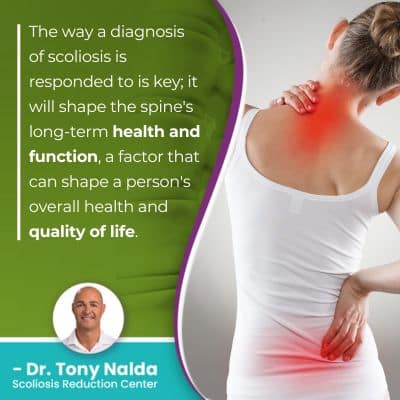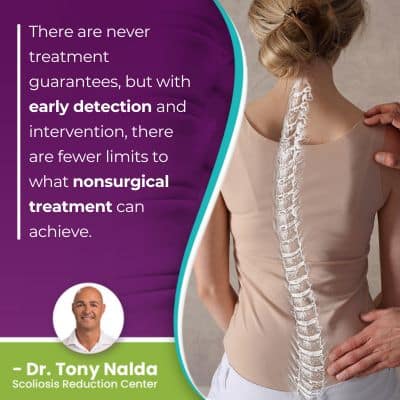Can Scoliosis Be Fixed? Is Surgery Necessary? [Find Out Here]

Scoliosis can be highly treatable, and this means addressing the condition's underlying structural nature in the form of a curvature reduction and increasing core strength so the spine can be optimally supported and stabilized.
Scoliosis can be treated, but it can't be cured. As a progressive condition, its nature is to get worse over time, particularly if left untreated. While each case is unique and treatment plans are customized, many cases of scoliosis don't require surgery, especially with early detection and intervention.
Scoliosis is a highly-variable condition that needs to be comprehensively assessed, classified, and addressed.
Table of Contents
Scoliosis Progression
Scoliosis progression is a serious concern, particularly for children, because progression is triggered by growth.
Scoliosis affects all ages, and as the leading spinal condition among school-aged children, awareness is warranted.
Scoliosis causes an unnatural and unhealthy spinal curve that bends to the side and rotates to develop, and as progression occurs, the size of the spinal curvature will increase, as will the condition's uneven forces, and their effects.
As scoliosis progresses, it's becoming more complex to treat as the spine is becoming increasingly rigid, less responsive to chiropractic treatment, and less capable of performing key therapeutic exercises as part of treatment.
Smaller curves are simpler to treat, and a treatment plan has to be customized to address key patient and condition variables such as patient age, condition type, severity, and curvature location.
Patient Age
Patient age is important because as a progressive condition triggered by growth, patients with growth yet to go through are more at risk for progression than adults; patient age is also important in terms of scoliosis pain.
Scoliosis doesn't become a compressive condition until skeletal maturity has been reached; while the spine is growing, the constant lengthening motion is counteracting the compressive force of the unnatural spinal curve, and it's compression of the spine and its surrounding muscles and nerves that causes the majority of condition-related pain.
Condition Type
 Condition type is determined by causation; approximately 80 percent of known cases have no known cause (idiopathic scoliosis), and the remaining 20 percent are associated with known causes: neuromuscular scoliosis, congenital scoliosis, and degenerative scoliosis.
Condition type is determined by causation; approximately 80 percent of known cases have no known cause (idiopathic scoliosis), and the remaining 20 percent are associated with known causes: neuromuscular scoliosis, congenital scoliosis, and degenerative scoliosis.
Condition Severity
Severity is determined by a measurement known as Cobb angle that's determined during X-ray; scoliosis ranges in severity from mild scoliosis to moderate scoliosis, severe and very severe scoliosis.
Curvature Location
There are three main spinal sections, and scoliosis can develop in any of them, or in more than one as a combined scoliosis: cervical spine (neck), thoracic spine (middle/upper back), and the lumbar spine (lower back).
So the key to fixing scoliosis is to manage it effectively so its effects are minimized, and in children, this means postural changes, and in adults, this means postural changes, back pain, and pain that radiates into the extremities due to nerve compression.
The way a diagnosis of scoliosis is responded to is key; it will shape the spine's long-term health and function, a factor that can shape a person's overall health and quality of life.
What is Scoliosis Surgery?
Scoliosis surgery is a type of spinal fusion, and it's a costly, invasive, and risky procedure.
All surgeries come with their share of risks, but spinal surgery can be particularly risky as the brain and spinal cord work in tandem to form the body's central nervous system.
The procedure can vary but commonly involves fusing the most-tilted vertebrae at the curve's apex into one solid bone, removing intervertebral discs sitting between adjacent vertebrae to be fused, and attaching a rod to the spine with screws to hold it in place.
Scoliosis surgery has the goal of stopping progression, not fixing or correcting scoliosis: an important distinction that we'll return to later.
Fusing the spine is contrary to its natural movement-based design, so it can cost the spine in a number of ways that can shape a person's quality of life.
The procedure itself is associated with the following risks:
- Nerve damage
- Infection
- Excessive blood loss
- Adverse reaction to hardware used
The long-term effects of spinal fusion aren't fully understood but can include:
- A noticeable loss in spinal flexibility and range of motion
- A spine that's weaker and more vulnerable to injury
- Pain at the fusion site
- Disappointing cosmetic results
- The psychological effect of knowing the spine is weak and vulnerable
- Potential activity restrictions
Scoliosis surgery can straighten a bent spine when successful, but is it worth the cost to spinal health and function it can be associated with?
The truth is that many cases of scoliosis don't require surgery, and this is where modern conservative chiropractic-centered treatment comes in.
The Power of Nonsurgical Scoliosis Treatment
There are never treatment guarantees, but with many progressive conditions, when treatment is started can be as important as the type of treatment started.
Here at the Scoliosis Reduction Center, conservative nonsurgical treatment is what I offer; this approach preserves as much of the spine's natural strength and function as possible, and it's a safe and noninvasive alternative to surgical treatment.
There are never treatment guarantees, but with early detection and intervention, there are fewer limits to what nonsurgical treatment can achieve.
Conservative treatment is chiropractic-centered and proactive; it's started as close to the time of diagnosis as possible with the goal of preventing progression and increasing condition effects, along with the need for surgical intervention in the future.
Conservative treatment is integrative and relies on the power of multiple condition-specific treatment disciplines to impact conditions on every level.
As a structural spinal condition, scoliosis has to primarily be impacted on a structural level, and this is worked towards through chiropractic care.
Chiropractic Care
 Condition-specific chiropractic care can involve a number of techniques and manual adjustments that can realign the spine by repositioning the curve's most-tilted vertebrae.
Condition-specific chiropractic care can involve a number of techniques and manual adjustments that can realign the spine by repositioning the curve's most-tilted vertebrae.
Chiropractic care can achieve a curvature reduction, and these results, along with what physical therapy, corrective bracing, and rehabilitation can support the structural changes.
Physical Therapy
Physical therapy for scoliosis treatment can strengthen core muscles so the spine is optimally supported and stabilized, and it can also address any related muscular imbalance, improve posture, and activate certain areas of the brain for enhanced brain-body communication.
Scoliosis-specific exercises can help keep the spine strong and flexible, along with its surrounding muscles.
Corrective Bracing
Corrective bracing can help correct scoliosis by pushing the spine into a corrective aligned position.
A scoliosis brace is worn around the torso and applies pressure at certain points along the curvature, and as bracing is particularly effective on growing spines, it is a regular facet of childhood scoliosis treatment.
An ultra-corrective ScoliBrace is my brace of choice here at the Center as it augments corrective treatment results and works by pushing the spine into a corrective position.
Rehabilitation
Rehabilitation can be the final and ongoing phase of treatment and can involve continued chiropractic care and the prescription of scoliosis-specific exercises to further stabilize the spine from home.
Rehabilitation can involve lifestyle guidance to ensure patients are leading a scoliosis-friendly lifestyle that preserves spinal strength and function.
Conclusion
So can scoliosis be fixed: it can be corrected, but as a progressive condition, scoliosis is incurable.
Scoliosis treatment is about how best to manage an ongoing condition for the best possible quality of life throughout treatment and beyond.
Scoliosis surgery is part of traditional scoliosis treatment but as traditional treatment doesn't have a strategy for treating scoliosis while mild, it does little to prevent progression, but responds with surgical recommendations when/if conditions become severe.
Conservative treatment, however, is proactive as it works towards preventing progression by starting treatment immediately following a diagnosis; scoliosis only gets more complex to treat the more it progresses, so the best way to fix scoliosis is to treat it while it's still mild and responsive.
Chiropractic-centered treatment is also known as functional treatment because it's aligned with the spine's movement-based design so preserves natural spinal strength and function.
There are a number of factors that shape a patient's scoliosis and their response to treatment such as patient age, condition type, severity, curvature location, and the chosen treatment approach.
There is still a place for scoliosis surgery in treatment, particularly in severe, atypical, and/or cases that have been left untreated, but the truth is that many scoliosis patients don't require surgery.
The best way to correct scoliosis is to recognize the condition's early signs so treatment can be started as close to the time of diagnosis as possible, when scoliosis is at its mildest and most likely to be responsive to treatment.
Dr. Tony Nalda
DOCTOR OF CHIROPRACTIC
After receiving an undergraduate degree in psychology and his Doctorate of Chiropractic from Life University, Dr. Nalda settled in Celebration, Florida and proceeded to build one of Central Florida’s most successful chiropractic clinics.
His experience with patients suffering from scoliosis, and the confusion and frustration they faced, led him to seek a specialty in scoliosis care. In 2006 he completed his Intensive Care Certification from CLEAR Institute, a leading scoliosis educational and certification center.
About Dr. Tony Nalda
 Ready to explore scoliosis treatment? Contact Us Now
Ready to explore scoliosis treatment? Contact Us Now





